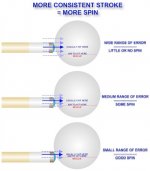What's good about a good stroke? If it's just consistency and accuracy like some say, how does that explain the ability to get more CB action with a better stroke?Some recent conversation about stroke reminded me of something Mike Page said about it years ago on RSB. This is my recollection of the gist of what Mike said.
Let's take draw for example. To get the most draw with the least effort we want to hit the CB as low as possible without risking a miscue. But our strokes aren't perfect, so to avoid miscues we have to aim far enough from the miscue limit so our usual stroke errors won't go beyond it.
We can't be trusted to do that so our subconscious does it for us, "steering" our stroke closer to centerball so our "range of usual stroke errors" will be mostly inside the miscue limit. Beginning players with really erratic strokes (wide "range of error") who have experienced the trauma of scooping the cue ball a few times can have a hard time forcing themselves to hit below centerball at all, wondering why they aim low but don't get any draw.
As our stroke gets more consistent and our "range of error" gets smaller, our subconscious steers our stroke less, allowing us to hit farther from centerball and get more draw more often. The smaller our "range of error" the closer our subconscious allows our stroke to come to where we think we're aiming.
pj
chgo

Last edited: